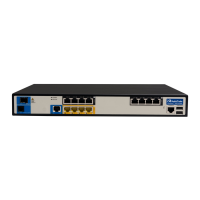IP Networking Configuration
Configuration Guide 82 Document #: LTRT-31657
13.1.4 Configuring Loopback Interfaces to Work with Voice
In some cases it is a good practice to use telephony traffic with the loopback interface. In
this case, if more than one WAN connection is being used, and one WAN connection fails,
the traffic is be able to flow via the secondary connection.
For Voice traffic, NAT rules need to be created for MSBR to forward traffic to the Voice
processor. If a global VRF is used to forward Voice traffic, the MSBR can be configured to
create these NAT rules automatically.
In order for the MSBR to route Voice traffic via the loopback interface, the loopback needs
to be bound to the saved “WAN” keyword in the voice configuration context. For this to
work, the sip-interface in the voice context needs to be assigned to the WAN keyword, and
loopback interface needs to be assigned to voice. In this way the MSBR will know to route
the voice traffic from LAN to WAN and vice versa using the Loopback interface.
The following is the required configuration to bind the loopback configuration to WAN
keyword.
To bind the loopback configuration to WAN keyword:
1. Bind the SIP interface to the WAN keyword.
MSBR# conf voip
MSBR(config-voip)# voip-network sip-interface 2
MSBR(sip-interface-2)# network-interface "WAN"
Note: Changes to this parameter will take effect when applying
the 'activate' or 'exit' command
MSBR(sip-interface-2)# exit
MSBR(config-voip)# exit
MSBR#
2. Configure the Loopback as WAN.
MSBR# configure data
MSBR(config-data)# interface loopback 1
MSBR(conf-if-Loopback 1)# network wan
MSBR(conf-if-Loopback 1)# exit
MSBR(config-data)# exit
MSBR#
3. Bind the loopback interface to the WAN.
MSBR# configure system
MSBR(config-system)# bind interface loopback 1 voip
Note: Changes will take effect after reset.
MSBR(config-system)*# exit
MSBR*#

